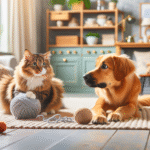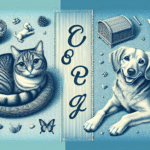Halloween Safety Tips for Dogs: Keep Your Pup Safe and Stress-Free
For many families, Halloween is one of the most anticipated nights of the year. Candy bowls overflow, kids put on their costumes, and neighborhoods glow with pumpkins and porch lights. But while the night is full of fun for people, it can feel confusing and even frightening for dogs. Doorbells ring nonstop, strangers in masks appear at the threshold, decorations flash and beep, and tempting bowls of candy sit just within nose range. Add in the unusual sights, sounds, and smells of the season, and it is easy to see why some pups struggle.
The good news is that with a little planning, you can make Halloween safe and enjoyable for everyone. In this guide, you will learn how to prevent the most common hazards, how to reduce noise- and costume-related stress, how to prepare for emergencies, and why boarding or daycare can be the easiest, kindest choice for some dogs. We will also draw on proven strategies used for thunder and fireworks fears so your pup can handle the holiday with more confidence.
Quick Halloween Dog Safety Checklist
Before we dive into details, here is a concise checklist to help you get the basics right:
- Keep all candy and gum out of reach. Chocolate, raisins/grapes, and sugar-free gum or sweets with xylitol are toxic to dogs (see AVMA’s Halloween pet safety guidance).
- Provide a calm space away from the door. Use a quiet room with a comfy bed, favorite toys, and soothing background sound.
- Make sure costumes fit properly. Avoid anything that impedes sight, breathing, or movement, and skip dangling pieces a dog could chew off.
- Keep candles, glow sticks, cords, and decorations out of reach. Opt for battery-powered candles; secure cords and keep small batteries and chewable decor away from curious mouths.
- Double-check your dog’s ID and microchip info. Confirm that tags are legible and chips are registered with current contact details.
- Know where to go in an emergency. Save your nearest emergency clinic’s number, or see Ethos Veterinary Health hospital locations and add one to your phone.
- Consider daycare or boarding. If your home will be busy or you will be out for the evening, daycare and boarding can provide a calm, supervised alternative.
- Use a secure leash and harness if going out. A well-fitted harness, reflective gear, and a short leash help prevent escapes in crowds or low light.
- Feed and exercise earlier. A well-exercised, well-fed dog is more likely to relax during the evening rush.
Now let’s explore how to put each of these steps into practice and the science-backed strategies that help dogs feel safe when life gets loud and unusual.
Why Halloween Can Be Scary for Dogs
Many dogs breeze through holidays without a care, but others find Halloween’s unusual combination of sounds, sights, and routines stressful. Research around thunder and fireworks fears sheds light on what makes any “noisy, unpredictable” event challenging for dogs—and how to help. Here are the most common factors:
Unpredictable Noise
Dogs hear better than we do, and sudden or irregular sounds can startle them. On Halloween, doorbells, knocks, laughter, squeaky decorations, and street chatter replace the usual quiet. Like thunder, the sound quality and volume vary in ways that dogs cannot predict. Over time, unexpected noise can build anxiety and trigger pacing, trembling, or attempts to escape.
Visual Changes and Costumes
Strangers in masks, tall hats, and capes move in atypical ways. Even familiar people—neighbors or family in costume—may look “wrong” to a dog. Decorations like moving witches or inflatables can add flashing lights, odd silhouettes, and motion. Many dogs rely on body language to feel safe; when faces and outlines are obscured, it can be unsettling.
Environmental Cues
Just as some dogs cue into atmospheric pressure shifts before storms, many notice the buildup to Halloween: pumpkins on porches, boxes of decor, and doorbell practice from kids. These new sights, smells, and routines tell them “something different is happening,” priming a sensitive dog to feel on edge.
Negative or Learned Associations
If a noisy event frightened your dog before—whether a slammed door, crowd noise, or a previous chaotic Halloween—they may generalize that fear to similar situations. Dogs are expert pattern-spotters, so one bad night can become a “predictor” of future stress unless you intentionally create calmer experiences.
Copycat Behavior and Caregiver Emotions
Dogs are social learners. They take cues from other pets and their humans. If you feel rushed or stressed answering the door or wrangling kids into costumes, your dog may mirror that tension. Staying calm and organized makes a real difference.
Inherited Sensitivity
Just like people, some dogs are naturally more cautious or noise-sensitive. Several studies suggest herding breeds, for example, may be predisposed to noise phobias. While you cannot change genetics, you can create thoughtful, predictable experiences that reduce fear and build coping skills.
Keep Candy and Seasonal Treats Secure
Halloween candy is a highlight for kids and a hazard for pups. Even small amounts of certain ingredients can cause serious illness. According to the AVMA, the biggest concerns are:
- Chocolate: Theobromine and caffeine can cause vomiting, diarrhea, agitation, elevated heart rate, tremors, and seizures. Dark chocolate is most dangerous.
- Xylitol: Found in some sugar-free gum, candies, and baked goods; can cause a rapid, life-threatening drop in blood sugar and liver failure.
- Raisins/Grapes: Even a small amount can trigger kidney failure in sensitive dogs.
- Alcohol and cannabis edibles: Seasonal party treats may be present; both can be toxic to pets.
- Wrappers and sticks: Foil, plastic wrappers, and lollipop sticks can cause choking or intestinal blockage.
Play it safe: keep all candy high up in closed containers, and do not leave trick-or-treat bowls or treat bags unattended. Teach kids a simple rule: no sharing human treats with pets—no exceptions. If you want your dog to join the fun, set aside pet-safe snacks and offer them at predictable times so your dog does not feel left out.
If ingestion happens: Do not wait for symptoms. Call your veterinarian or the Pet Poison Helpline for guidance. Symptoms may include vomiting, diarrhea, drooling, lethargy, agitation, tremors, or collapse. Do not induce vomiting unless directed by a veterinary professional.
Decoration and Costume Safety
Decorations and costumes make the holiday festive, but they can introduce hazards and discomfort if not managed thoughtfully.
Decoration Do’s and Don’ts
- Use flameless candles. Real candles in jack-o’-lanterns or around doorways can be knocked over, risking burns or fire.
- Hide cords and secure batteries. Chewed cords can cause burns or electrocution; batteries are a choking hazard and can cause corrosive injury if punctured.
- Keep glow sticks out of reach. Most are low-toxicity but can cause drooling and irritation; they also invite chewing.
- Place decor at dog height with care. Dangling tinsel, moving props, and small figurines tempt curious noses.
- Mind pumpkins and corn. Moldy pumpkins or corn cobs left outside can upset stomachs or cause blockages.
Costume Comfort Comes First
- Fit matters. Costumes should not obstruct vision, breathing, or movement. Avoid tight elastics and heavy or stiff fabrics.
- No chewable bits. Skip costumes with beads, bells, or pieces that dangle and invite nibbling.
- Practice early. Introduce the costume in short, positive sessions days ahead. Reward calm behavior; remove it at the first sign of stress.
- Supervise at all times. Never leave a costumed pet unattended, especially around decorations, candles, or other animals.
- Use a harness under the costume. This preserves safe leash control and prevents costume failures at the door.
- Reflective accents help. If you will be outdoors, add reflective tape or lights so your dog is visible.
- Read your dog’s body language. If your pup looks stiff, tucks their tail, shakes, or tries to remove the outfit, opt for a festive bandana or collar charm instead.
Reducing Stress During Trick-or-Treating
Doorbells and frequent visitors are the number-one stressors for many dogs on Halloween. A well-planned “quiet zone” and a few training tweaks go a long way.
Create a Calm Retreat
- Pick the room. Choose a space away from the front door—ideally interior, with fewer windows and street noise.
- Make it cozy. Include your dog’s bed, a crate if they are crate-trained, favorite toys, and a water bowl.
- Add soothing sound. Turn on a white noise machine or calming music for dogs to mask outside sounds.
- Offer a long-lasting chew or puzzle. Stuffed food puzzles, lick mats, or safe chews help reduce arousal through licking and sniffing.
- Use barriers. Secure baby gates or closed doors so your dog cannot dart out when the door opens.
Pre-Party Exercise and Routine
- Walk early. Take a longer walk or play session earlier in the day so your dog’s body is pleasantly tired by evening.
- Feed ahead of time. A slightly early dinner helps reduce scavenging and sets a predictable routine.
- Bathroom break before the rush. Avoid accidents and outdoor scares by timing a calm potty trip before trick-or-treaters arrive.
Desensitize Doorbell and Costume Surprises
Borrow a page from thunder desensitization: build positive associations with the very things that worry your dog.
- Doorbell party game: A few days before Halloween, ask a family member to ring the doorbell once. Say “Yes!” or “Treat!” in a cheerful voice and immediately scatter a few small, high-value treats on the floor. Repeat slowly, ending before your dog loses interest. Over sessions, ring from different angles and vary timing. On Halloween night, continue to toss treats in your dog’s retreat space with each ring if they are within earshot.
- Costume introductions: Let family members try on costume pieces one at a time while rewarding your dog for calm looks and sniffs. Avoid looming; move slowly and sideways to appear less threatening.
- Practice with the door. Rehearse calmly opening and closing the door while your dog remains behind a gate or in their retreat, earning rewards for staying settled.
Comfort Is Not “Spoiling”
A common myth says comforting a fearful dog will reinforce fear. It won’t. As behavior experts note, comfort cannot worsen fear. If your dog seeks closeness, quietly provide it—soft voice, slow strokes, and steady presence. The goal is to help them feel safe, not to force braveness.
Helpful Calming Aids
- Snug vests or “thunder shirts.” These can provide gentle, constant pressure that helps some dogs relax.
- Dog-appeasing pheromones. Plug-in diffusers, sprays, or collars can help create a calmer baseline environment.
- Ear muffs or wraps. Sound-dampening gear may help but should be introduced gradually—never the first time during the event.
- Calming music and white noise. Start before the evening rush rather than after your dog is already stressed.
Going Out With Your Dog on Halloween
Some dogs enjoy strolling with the family. If you plan to include your pup outside, emphasize safety and consent.
- Know your dog. If your dog is wary of strangers, reactive, or noise-sensitive, they are likely happier at home in their calm retreat.
- Use secure gear. A well-fitted harness and a sturdy, short leash (no retractables) give you better control.
- Light it up. Add reflective collars, clip-on lights, or a light-up leash so drivers and pedestrians can see you.
- Bring ID. Double-check the tag and microchip registration before Halloween night.
- Watch the ground. Be vigilant for dropped candy and wrappers; steer your dog away and keep a “leave it” cue ready.
- Keep interactions brief and optional. Do not force greetings with costumed children or adults; your dog should be able to move away easily.
- Take breaks. Short outing, then back to the retreat with a chew or puzzle can be the perfect compromise.
When to Seek Veterinary Help
Despite best planning, accidents can happen. During Halloween week, calls to the Pet Poison Helpline rise significantly. If your dog ingests a potential toxin, experiences burns, or shows signs of acute distress, do not wait—quick action matters.
Emergency Red Flags
- Repeated vomiting or diarrhea
- Drooling, tremors, staggering, or seizures
- Sudden collapse or extreme lethargy
- Foaming at the mouth or difficulty breathing
- Swollen, painful belly; retching without producing vomit
- Burns or suspected electrical shock (from cords)
Know your nearest emergency veterinary clinic and keep their number handy. If you do not have a plan, Ethos Veterinary Health operates a nationwide network of specialty and emergency hospitals dedicated to providing world-class care and compassion when pets need it most. Save the number of your closest Ethos hospital in your phone now so you do not lose precious time in an emergency.
Important: Do not give human medications or induce vomiting unless a veterinarian instructs you to do so. If you are unsure, call your vet or the Pet Poison Helpline for guidance based on what your dog ate and when.
Consider Boarding or Daycare for Peace of Mind
Sometimes the kindest choice is to remove your pup from the chaos altogether. If you are hosting a party, expect steady trick-or-treat traffic, or plan to be out for hours, boarding or daycare can provide a quiet, supervised environment where dogs can relax and play while you enjoy the night stress-free.
At PetSuites, dogs enjoy attentive care, supervised playgroups, and enrichment activities designed to keep minds busy and bodies content. Many locations even host lighthearted Halloween activities like themed photo shoots, dog-friendly trick-or-treating, costume contests, and raffles. Booking a stay gives your dog a safe, fun way to “celebrate” while protecting them from the doorbell rush and candy temptations at home.
How to Prepare for a Boarding or Daycare Stay
- Book early. Halloween is a popular time; reserve your preferred dates in advance.
- Pack familiar comforts. A favorite blanket or toy can help your dog settle quickly.
- Share your dog’s routine. Feeding, medication, and preferred play styles help staff personalize care.
- Confirm vaccine requirements. Ensure your dog’s vaccinations are up-to-date ahead of time.
- Do a “trial run.” If your dog is new to boarding, a half-day of daycare before Halloween can build familiarity and confidence.
What Thunder and Firework Strategies Teach Us About Halloween
Research and real-world experience with thunder and fireworks fears offer proven tools you can adapt for Halloween’s unique stressors.
Be a Calm Role Model
Dogs often mirror our emotional state. Keep your voice steady, move unhurriedly, and prepare your entryway setup before the first trick-or-treater arrives. When you feel organized, your dog often follows suit.
Build Positive Associations Before Stress Peaks
Just as you might pair thunderclaps with treats, pair doorbell sounds, costume glimpses, and porch chatter with calm praise and rewards. Keep sessions short and successful, then stop before your dog gets overwhelmed.
Comfort Without Hesitation
If your dog seeks closeness, offer it. Gentle petting, a soft voice, and your calm presence communicate safety. You are not “reinforcing fear”—you are helping your dog self-regulate.
Sound Management Is Powerful
Use white noise, calming music, or a fan in your dog’s retreat to muffle door and street sounds. In apartments, thicker walls may naturally buffer noise; in houses, consider adding a white noise machine near the door and the dog’s rest area.
Support Tools Can Help
- Snug vests: Many dogs relax with gentle pressure garments; practice wearing them ahead of time.
- Pheromone support: Diffusers, collars, or sprays can help reduce baseline anxiety.
- Ear wraps or muffs: Introduce slowly with treats well before the event so they are not an added stressor.
Talk to Your Veterinarian
If your dog experiences significant distress around noises or visitors, consult your veterinarian. They can suggest behavioral strategies and may recommend anti-anxiety medications or supplements tailored to your dog. Begin this conversation days to weeks ahead of holidays so you have time to test what works best.
A Step-by-Step Plan for a Calm, Safe Halloween
1–2 Weeks Before
- Check ID and microchip. Update contact info and ensure tags are secure and readable.
- Gather supplies. Treats, chews, puzzle feeders, baby gates, white noise machine, pheromone diffuser, and any calming vest.
- Practice doorbell games. Pair a single ring or knock with tossed treats. Keep sessions short and fun.
- Introduce costumes. Try on pieces for seconds at a time with treats, gradually increasing duration only if your dog stays relaxed.
- Set up the retreat room. Place the bed/crate, water bowl, toys, and noise machine now so it becomes a familiar safe spot.
- Confirm your emergency plan. Save your veterinarian’s info and add your closest Ethos hospital number.
- Consider daycare/boarding. If your dog is likely to struggle, reserve a spot at your local PetSuites.
3–5 Days Before
- Secure the candy plan. Store candy in closed containers out of reach; set up a kid-proof “no sharing with pets” rule.
- Dog-proof decor. Tape down cords, switch to flameless candles, and lift chewable decor out of reach.
- Rehearse the routine. Practice opening and closing the door while your dog relaxes behind a gate, earning a calm treat scatter.
- Gather walking gear. Check harness fit, leash condition, reflective gear, and poop bags.
- Test aids. Plug in pheromone diffusers, try the snug vest for short sessions, and preview calming music.
Halloween Morning
- Exercise early. A longer walk or play session helps reduce evening restlessness.
- Feed slightly early. A satisfied stomach and a predictable routine set the tone for a calmer evening.
- Stock the retreat room. Prepare stuffed Kongs, lick mats, and chews. Pre-freeze some for longer engagement.
- Prep the entryway. Place candy out of reach, position a table or stand so you can hand out treats without opening the door widely, and consider a sign asking visitors not to ring if you plan to sit outside.
During Trick-or-Treat Hours
- Settle your dog first. Guide them to their retreat, turn on white noise/music, and offer a high-value chew.
- Use barriers. Close the door or secure baby gates to prevent dashes when you answer.
- Stay calm and consistent. Move deliberately, speak softly, and reward your dog for calm moments if they are within earshot.
- Take mini breaks. If safe, step outside to hand out candy and avoid constant door opening and closing.
- Keep an eye on stress. If your dog becomes agitated, increase distance from the noise, add a second sound layer, or try a short relaxation break with you present.
After the Last Visitor
- Do a candy sweep. Check floors, porch, yard, and sidewalks for dropped treats or wrappers.
- Offer decompression time. A short sniffy walk or quiet cuddle helps your dog reset.
- Praise generously. Celebrate your dog’s successes—calm behavior deserves calm rewards.
Special Considerations for Different Dogs
Puppies
Focus on gentle exposure. Keep costume and doorbell practice brief, pair with treats, and avoid overwhelming situations. Halloween is a chance to build positive associations that can last a lifetime, not a “test” of bravery.
Senior Dogs
Older dogs often prefer predictability and quiet. Some may be less reactive to noise due to reduced hearing, but others can be more sensitive overall. Provide extra padding for joints in the retreat space, keep pathways clear, and avoid costumes that add weight or restrict movement.
Rescue or Newly Adopted Dogs
New environments are already a lot to process. Keep Halloween simple: stick to a calm retreat, quiet reinforcement, and controlled exposure only if your dog is curious and relaxed.
Dogs with a History of Noise Phobia
Plan like you would for thunderstorms or fireworks. Use your established toolkit—pheromones, snug vests, white noise, and any veterinarian-recommended medications or supplements. Consider daycare for daytime and early evening, or boarding if guests and doorbells will persist late into the night.
Entryway Safety: Tiny Tweaks, Big Payoff
- Use a table stand. Place candy on a small table outside if you plan to sit on the porch, reducing frequent door opening and potential escapes.
- Leash before opening. If your dog must be near the entry, clip the leash to a harness before you open the door—even if you have a fenced yard.
- Train a “station” behavior. Teach your dog to settle on a mat for treats as the door opens and closes during practice sessions.
- Consider a sign. A friendly “Please do not knock—ring bell once” or “Quietly take one—nervous dog inside” sign can reduce repeated triggers.
Your Halloween Emergency Readiness Kit
- Clinic contacts. Your primary vet, nearest emergency clinic, and an Ethos hospital number saved and posted.
- Pet Poison Helpline info. Keep their number handy and the Halloween toxin page bookmarked.
- Essentials. Extra leash/harness, towels, flashlight, poop bags, water, and a small first-aid kit.
- Crate or carrier (if used). For safe transport if a trip to the vet becomes necessary.
- Medication and instructions. If your vet provided anti-anxiety meds or supplements, have them ready with dosing guidelines.
Frequently Asked “Is This Safe?” Questions
Is pumpkin safe for dogs?
Plain cooked pumpkin (no spices or sweeteners) can be a gentle treat for some dogs in small amounts. Pumpkin pies, spiced lattes, and seasoned or moldy porch pumpkins are not safe.
Are glow sticks dangerous?
They are typically low in toxicity but can cause drooling and mouth irritation and encourage chewing. Keep them out of reach and discard damaged items promptly.
Can I let my dog greet trick-or-treaters?
Only if your dog truly enjoys strangers and costume chaos—and only with a secure leash or barrier in place. Many friendly dogs still find Halloween overstimulating, so opt for brief, optional greetings or keep your dog settling happily in their retreat.
What if my dog barks at every ring?
That is normal and manageable. Use white noise, doorbell desensitization games, and an occupied mouth (chew or lick mat) in a quiet room. If barking escalates, increase distance from the door and add another sound layer to muffle triggers.
Wrapping Up a Safe (and Fun) Halloween
Halloween does not have to be a stressful night for your dog. By keeping candy secure, managing entryway chaos, thoughtfully introducing costumes and decorations, and creating a calm retreat with smart sound management, you can protect your pup from common hazards and keep stress low. When in doubt, choose the gentler option: offer comfort, reduce triggers, and give your dog a predictable place to relax. If an emergency arises, having your veterinary contacts—and a nearby Ethos Veterinary Health hospital—saved in your phone helps you act fast.
And if your home will be bustling, consider letting your dog enjoy a “holiday of their own” at daycare or boarding. At PetSuites, our trained teams provide a safe, supervised environment with enrichment and, at many locations, festive themed fun, so you can celebrate knowing your best friend is comfortable and cared for. Ready to plan ahead? Find your local PetSuites and book early, and explore our pet parent guides for more seasonal tips throughout the year.
How does your dog handle Halloween, and what’s one strategy from this guide you’re excited to try or customize for your pup this year?







